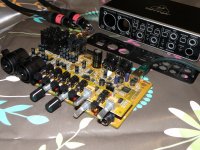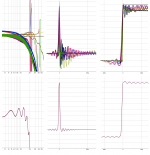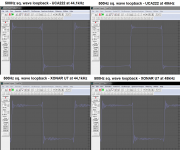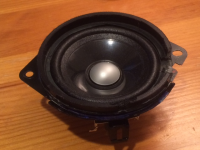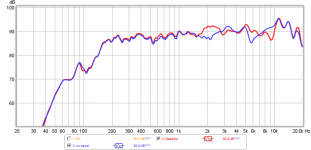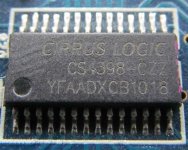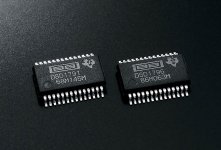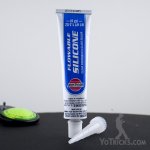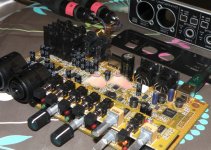It sounds should be good seen from here! Design close to the Manzanita....
It makes me scratch my head about the need of a tweeter or the XOs with those little FR !
Very interresting...
For the small sizes : we have some good ones many seem to like: the Vifas TC9 family, the ScanSpeak 10F, The FR88 (smooth metal, rare !)..., maybe the F80 in the paper family (although this one lacked détails on my systems) !
It makes me scratch my head about the need of a tweeter or the XOs with those little FR !
Very interresting...
For the small sizes : we have some good ones many seem to like: the Vifas TC9 family, the ScanSpeak 10F, The FR88 (smooth metal, rare !)..., maybe the F80 in the paper family (although this one lacked détails on my systems) !
So what's the general decision on the Fountek drivers? I was hoping one of them would win. I rated the Alpine worst and was quite surprised it won. I'll pass on purchasing it.
I rated the FR88EX highest in this round, after a battle between the TC7 and the FR88EX.
It has a pretty clean sound, seeing you wanted a bit more than the TC9, maybe a bit less than the PS95 it could fit your profile? For an alu cone it's well behaved. Might give you a bit more sparkle than the TC9.
I still think the Alpine was broken
Do we have distortion measurements for this round?
I almost forgot about that. I think I took distortion measurements for all the drivers - 96dB SPL at 0.5m or 90dB at 1m equivalent. I will post them once I get back to my computer as I am in transit now.
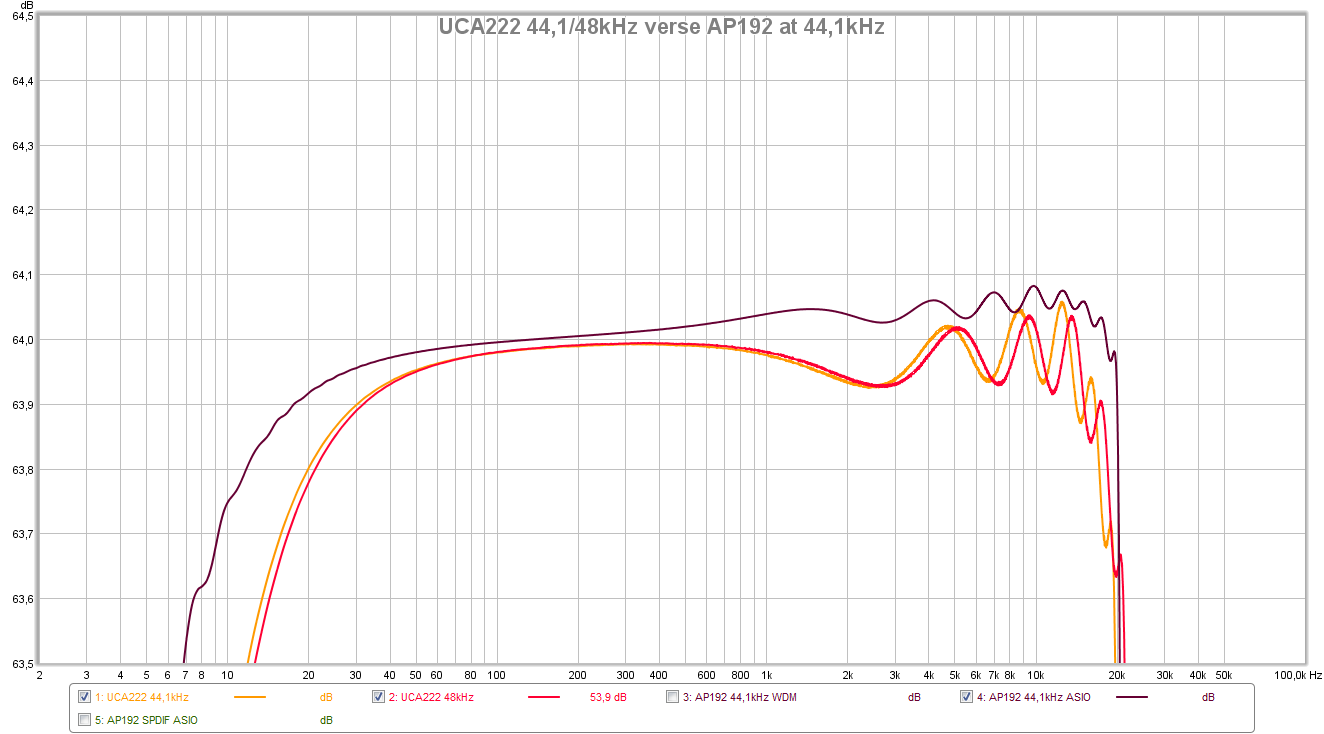
The differences in tiny ripple at HF are not the primary source in sound quality differences between DACs. High pass behavior of DAC and following amplification stages is bigger player. Looking at big picture of step response zero crossing, phase response/group delay <100Hz is more telling. In a nutshell, it's getting transient perfect response to low frequencies. Problem starts with high pass filter on electrical side, and continues with high pass behavior of transducers.
BYRTT; in this set of plots:
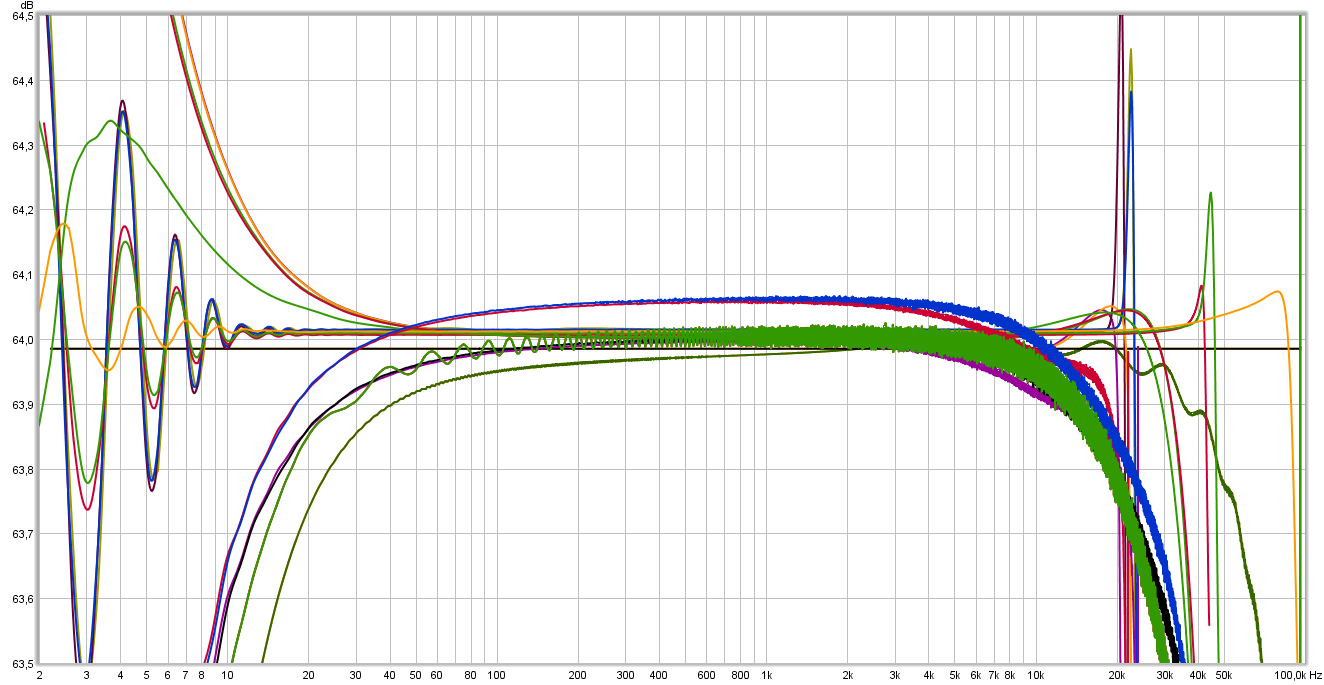
you appear to have some DC coupled DACs? How do these compare in bass realism to UCA222?
Thanks sharing your experience regarding problems start with high pass filter on electric side, and continues with high pass behavior of transducers. Will remember this and have some covered and experienced as seen below.
Have a DC coupled DAC but its not shown in the FR plot (DC performer in plot is AP192 SPDIF I/O loop), my setup for SPH-250KE combined 10F/8424 FAST system has until some days ago been - dedicated desktop computer/JRiver player (route-mix-XO 2way-EQ-FIR convolution)/HIFImeDIY UA23 TE7022 Toskon out (not using ES9023)/Behringer SRC2496 upsample 44,1 to 88,2 and 48 to 96kHZ Toskon out/Behringer DEQ2496 as DAC (AKM4393) all effects bypassed and DAC is modded to be DC coupled/Sansui AU-D9 (DC-coupled ab fabric).
As you see i modded DAC in DEQ2496 because then bass get more realism, that's of course a subjective opinion but can back it up by beautifully linear GD down from DC. The thing some years ago that triggered me try DC couple DEQ2496 was my old power amps acquired 1983 (2x stereo AU-D9) had always impressed me in lows compared to any thing else up thru the years.
The thing that triggered me post the plots with 3x DACs was to share that because we hear some new in audio stream and new silicone used aught to be a improvement, its sadly not always so. Example at my every day work horse desktop computer have a set cheap EDIROL MA-5A one way full range desktop speakers with build in power amps and need just a stereo sound device to feed them, also mostly play local 44,1kHz Danish internet radio or own captured 16bit/44,1kHz CD's. In Juli 2013 i exchanged UCA222 by a brand new 24bit XONAR U7 and didn't like the sound for my use, so back got the UCA222. But now i need a sound device with at least 4x outputs to get FAST system up running real stereo steered from JRiver's DSP stomach and therefor XONAR U7 is surfacing again because it has 8x outputs and lately bought a Behringer UMC204HD. The plots at post 186 with the forrest of traces is newer XONAR U7, UMC204HD and good old PCI card AP192 and while AP192 is old its perfect whatever sample rate it runs, also nearly whatever buffer settings and whatever its running WDM/WASAPI/ASIO. The ugly traces in plots stands for XONAR U7 and UMC204HD except when they run 176.4 and 192kHz and carefull choosen buffers and they best at WASAPI only. Reason i don't use AP192 is 2x output is analog and other two is SPDIF and at same like at newer motherboards to have soundcard electric interface routed direct to CPU and not via platform chipset. Own a XONAR ESSENCE ST too which via a PCI/PCIe bridge would work but it doesn't support 88,2/176,4kHz : ( and after various tests prefer to have 44,1kHz upsampled to 88,2/176,4kHz and 48kHz to 96/192kHz.
Now that XONAR U7 and UMC204HD actual perform well objective data and subjective too : ) when running 176,4/192kHz they usefull if setting up sampling rule inside JRiver where all 44,1/88,2/176,4/352,8 goes 176,4kHz and all 48/96/192/384 goes 192kHz. And this is perfect for a exercise try some IRR and FIR correction above 20kHz area to have 10F/8424 not go BW2 cut off slope at HF but a softer BES2 slope to improve ringing and a FIR filter to linearize 90º phase turn at 10F's HF cut off -3dB point. For some days had running this correction as a theoretical predict setting and while it subjective sound as setup got even more realism need to figure out how to measure because UMIK-1 and UMM-6 haven't the bandwidth needed up in HF area. Also running 176,4 or and 192kHz downstream all containers inside JRiver DSP take some CPU power raising to 10-15% but worst is my FIR filters got so long that REW get their correction wrong and need seek help for this point, even sound is subjective perfect need confirmation via objective data. Had a measurement check with square waves routet through speakers after the HF mod, and before mod square wave look faded at 4kHz, now that look is upped to 5,5kHz. Will have a look later if these USB sound devices can be mod to have DC coupled output with low DC offset as was possible the AKM4393 inside DEQ2496 but not shure its as easy with Cirrus Logic DACs.
Picture 1 is XONAR U7 in duty, has nice silicone, output 1/2 is CS4398 and output 3-8 is CS4362.
Picture 2 is UMC204HD in duty, also has nice silicone, output 1-4 is via a CS4272 and CS4271 and has same spec as U7's CS4362. Also this has a XMOS 8U6C5 USB chip and as far i know XMOS run asynchronous USB sync. Had tried run free "Thesycon USB Descriptor Dumper" tool to check and while it looks that at various point in report that asynchronous sync is going on not shure I'm wise enough to understand it right and running it for U7 it also looks at various points that asynchronous sync is going on. At www.thesycon.de the tool is avaible and also their "DPC Latency Checker" tool is convenient for optimize computer better to stream audio.
Picture 3 good old AP192 with aging PCI interface.
Picture 4 at lowest traces UCA222 and should be no problem the wiggles in FR because vertical scale is 0,1dB division a overall 1dB range, verse plots at post 186 where some ugly not thin traces is found in FR and a lot of ringing is going on if one not select particular sampling rate, buffer settings and select right for WDM/WASAPI/ASIO use.
Picture 5 square waves UCA222 44,1/48kHz verse XONAR U7 square waves 44,1/48kHz.
Attachments
Last edited:
I seem to remember them saying that the Jeep driver was intended to be listened to some degrees off axis 45 or so as it is laid flat relative to the listener and installed in a panel or ceiling space. This would obviously change its performance.
It could well be that it's faulty. A decoupled centre cap would require some precision to align and glue properly. QC can't exactly be amazing in a driver so inexpensive but then again the driver might not be as good they were trying to sell it as being.
It could well be that it's faulty. A decoupled centre cap would require some precision to align and glue properly. QC can't exactly be amazing in a driver so inexpensive but then again the driver might not be as good they were trying to sell it as being.
Mea Culpa
Wesayso insists:
OK, I confess, I removed the bezel on the Alpine driver because I thought it would sound better. You would think that a 0.30in tall x 0.13in thick x 3.10in inside diameter plastic ring placed around a driver would cause all sorts of diffraction anomalies, etc. right? Removing the bezel, reduced a 2.1kHz peak that was very noticeable to my ears and made it sound better, subjectively - less "shouty". However, it shifted a dip that was at 9kHz to 5.5kHz. Subjectively, narrow dips are not as noticeable as peaks. So I made a call and thought the driver sounds better without the stock bezel (which also has a fine fabric mesh grille glued to it). There was no difference with and without the grille cloth.
Here is a comparison of the Alpine with and without the bezel:
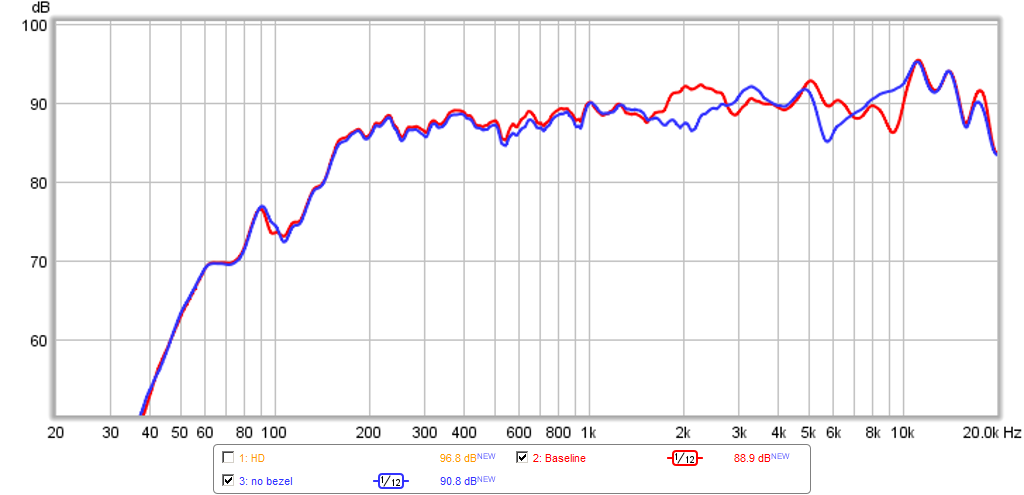
Here is a photo of the driver with the bezel placed on top:
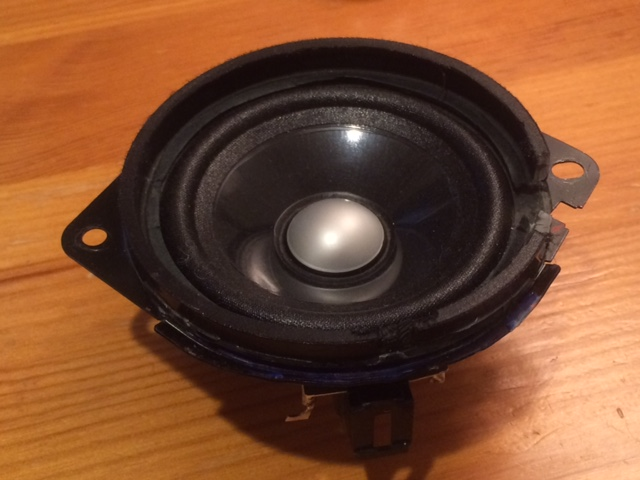
Here is a photo of the bezel all by itself. It was glued on and has a paper backing that forms a lip on the bottom where the glue affixes it to the frame:
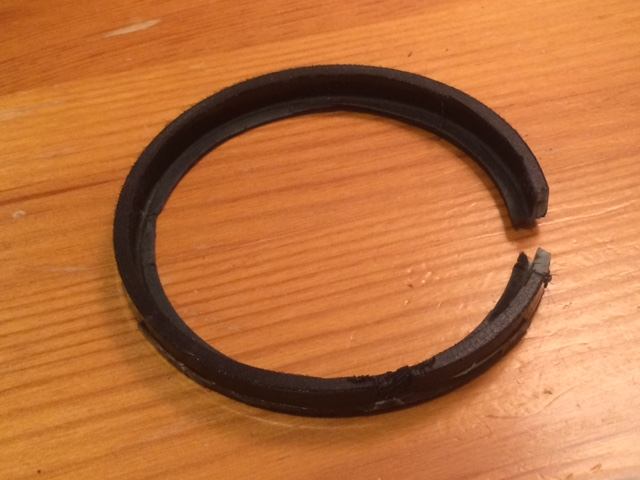
My question is, would this driver not have done as well if I had left the bezel on? I guess we won't know now that the poll has closed.
So, I guess Wesayso was right - it was broken. But in my mind, broken was better.
Anyhow, I will take the mea culpa for anyone who may have mis-voted based on my tampering with the stock design for the Alpine. Btw, if you left the bezel, mounting it would look kind of funny with a ring there. I guess you could rebate it but that may make it worse.
Alpines measurements for the driver are quite similar except they don't show that peak/dip combo at 5-6kHz.
Wesayso insists:
I still think the Alpine was broken. :Wink:
OK, I confess, I removed the bezel on the Alpine driver because I thought it would sound better. You would think that a 0.30in tall x 0.13in thick x 3.10in inside diameter plastic ring placed around a driver would cause all sorts of diffraction anomalies, etc. right? Removing the bezel, reduced a 2.1kHz peak that was very noticeable to my ears and made it sound better, subjectively - less "shouty". However, it shifted a dip that was at 9kHz to 5.5kHz. Subjectively, narrow dips are not as noticeable as peaks. So I made a call and thought the driver sounds better without the stock bezel (which also has a fine fabric mesh grille glued to it). There was no difference with and without the grille cloth.
Here is a comparison of the Alpine with and without the bezel:

Here is a photo of the driver with the bezel placed on top:

Here is a photo of the bezel all by itself. It was glued on and has a paper backing that forms a lip on the bottom where the glue affixes it to the frame:

My question is, would this driver not have done as well if I had left the bezel on? I guess we won't know now that the poll has closed.
So, I guess Wesayso was right - it was broken. But in my mind, broken was better.
Anyhow, I will take the mea culpa for anyone who may have mis-voted based on my tampering with the stock design for the Alpine. Btw, if you left the bezel, mounting it would look kind of funny with a ring there. I guess you could rebate it but that may make it worse.
Attachments
Last edited:
What is meant by "silicone" as applied to DACs?
Maybe language trouble or understanding by me.
.....But in my mind, broken was better.....
On plot looks good enough a mod, think would have made signature its own no matter.
Picture 1 is XONAR U7 in duty, has nice silicone, output 1/2 is CS4398 and output 3-8 is CS4362.
In the photo, I guess I don't understand where the nice silicone is? Silicone is usually used to refer to a soft pliable caulking or putty sealant, also known as RTV or room temperature vulcanizing rubber. Generally high temperature resistant. Also used to refer to any silicon-based oil like mold release agent or race car brake fluid.
BYRTT's form of silicon:


Silicon
Here's my silicon:

Is this yours X? Silicone


P.S. googling for silicone I could have picked a worse example (lol)
Silicon
Here's my silicon:
Is this yours X? Silicone
P.S. googling for silicone I could have picked a worse example (lol)
Attachments
Last edited:
- Home
- Loudspeakers
- Full Range
- A Subjective Blind Comparison of 2in to 3.5in drivers - Round 5

